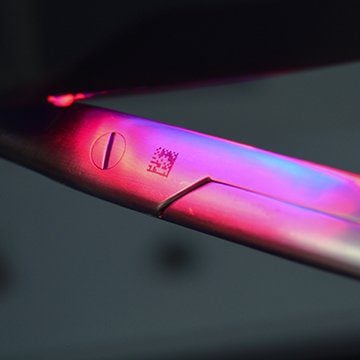Keeping track of individual instruments is critical to your organizational health. The old process of only tracking trays of instruments isn’t good enough. You need the data management that comes from knowing which instrument was used on which patient, which tray it goes in, and when it’s due for maintenance.
Recently, we sat down with Jennifer Bingaman, Director of Business Services, and Bill Camargo, Manager of Marking Services, for Censis to explain why instrument marking and tracking are so important.
Innovation is usually the result of a problem. What was the impetus for instrument marking and tracking?
It started with concerns for patient safety and a growing need to identify instruments used on specific patients. While hospitals were tracking at the tray level, we couldn’t track to the exact instrument when there was a recall, repair need, or even a CJD event. That didn’t give us enough information if a specific instrument had a recall or a problem. For instance, if an instrument has to be sharpened every ten uses, we couldn’t track maintenance history at the instrument level.
How do you track individual instruments?
There are different techniques to add an indelible barcode without affecting the instrument. Instruments are marked with a unique 2-D barcode usually using a laser or an electrochemical marking device. During assembly, the user scans an instrument so that CensiTrac knows the exact instrument that is in the tray. When all the instruments are marked and scanned in, assembling the right instruments for a tray is so much easier. It also provides a failsafe. An instrument scanned to go into a set might be flagged as due for maintenance, and can easily be swapped out for a different one.
How does instrument-level tracking technology improve data output for Sterile Processing?
When you know what set was sterilized and what instruments were in the set, if there is an infection issue, you can identify the instruments and their history without having to recall all the trays.
Can instrument-level tracking help a hospital identify gaps in processes?
It creates a verification process for assembly of the sets. When building a tray, the technician scans each instrument to make sure the tray is complete. If a different instrument is needed for a specific procedure, the tech can locate one and pull it.
How long has CensiMark been available to clients?
Since 2015, Censis is still the only surgical tracking company that offers marking instrument services. Some people are afraid of instrument-level marking and don’t see the value. They see marking and scanning instruments as a giant effort for their tight staffing. To make it easier, we have teams that come in and mark the hospital’s instruments for them. Plus, trainers can be scheduled to instruct your staff on using the marking equipment to maintain inventory. After that, they just have to mark and scan new instruments, usually in small batches.
Our clients often end up establishing a real relationship with the marking team, partly because they know we are sensitive to not disrupting their normal operations, and can adjust our work time to the days and hours that work better for them.
A pillar of Censis is relationship-building with clients. When we have a team onsite doing marking, they may find sets of single-use instruments mixed in or identify damaged or worn instruments that shouldn’t be used. By having the right people, we can see problems and head them off, providing valuable teaching moments for our clients to make them successful and confident.
What are your challenges going forward?
Some hospitals mark instruments but don’t scan them. They are losing much of the value of the process. We can walk them through and show them how tracking can make their lives easier, sharing success stories and data from hospitals that maximize their use of tracking.


